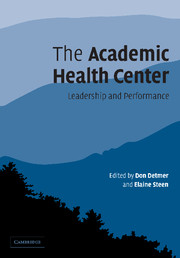Book contents
- Frontmatter
- Contents
- List of figures
- List of tables
- Foreword
- Acknowledgments
- List of contributors
- Introduction
- 1 Academic health centers: current status, future challenges
- 2 A health system for the twenty-first century
- 3 Stronger leadership in and by academic health centers
- 4 Pursuing organizational and cultural change
- 5 Managing and leveraging organizational knowledge
- 6 e-Health challenges and opportunities
- 7 Organizational challenges facing the European academic health center
- Index
- References
1 - Academic health centers: current status, future challenges
Published online by Cambridge University Press: 12 November 2009
- Frontmatter
- Contents
- List of figures
- List of tables
- Foreword
- Acknowledgments
- List of contributors
- Introduction
- 1 Academic health centers: current status, future challenges
- 2 A health system for the twenty-first century
- 3 Stronger leadership in and by academic health centers
- 4 Pursuing organizational and cultural change
- 5 Managing and leveraging organizational knowledge
- 6 e-Health challenges and opportunities
- 7 Organizational challenges facing the European academic health center
- Index
- References
Summary
Introduction
The decade of the 1990s was unprecedented in the history of the modern academic health centers (AHCs) in the United States, as it was for health care institutions generally. The nation's 125 AHCs had for the previous 40 years grown steadily larger, more powerful, and more lustrous. They had built or acquired hospitals, outpatient buildings, and research facilities. Their faculties had captured an enviable share of Nobel prizes in their fields and pioneered life-saving treatments for cardiovascular disease, cancer, and other illnesses. Despite occasional storms associated with the introduction of new Medicare payment policies (i.e., diagnosis-related groups or DRGs and the resource-based relative value system or RBRVS), AHCs' clinical facilities had mostly sailed to higher volumes of patient care, higher clinical income, and increasing fiscal reserves. If few administrators or board members from parent universities understood the intricacies of these complex medical institutions – their peculiar organizational structures, accounting practices, promotion rituals, and cultures – well, there were other parts of the university that were both more comprehensible and more problematic. Academic health centers did not appear broken, or to need fixing.
All that changed dramatically for many AHCs and their parent universities in the middle and late 1990s. Out of a seemingly clear horizon, a tidal wave of red ink crashed across the balance sheets of some of the nation's most eminent and heretofore invulnerable AHCs.
- Type
- Chapter
- Information
- The Academic Health CenterLeadership and Performance, pp. 4 - 25Publisher: Cambridge University PressPrint publication year: 2005
References
- 1
- Cited by



